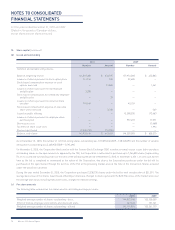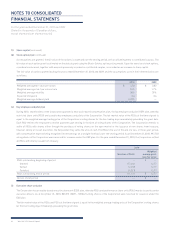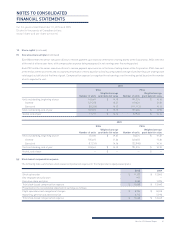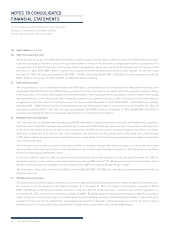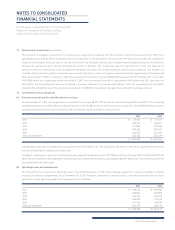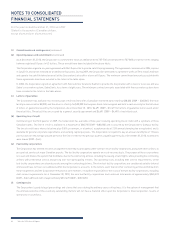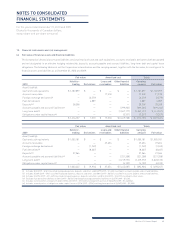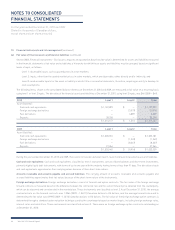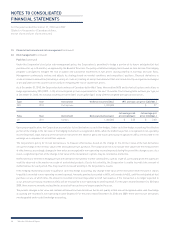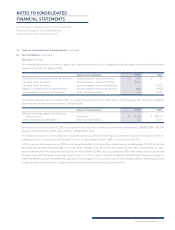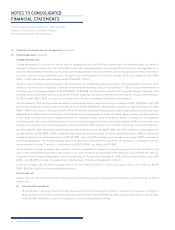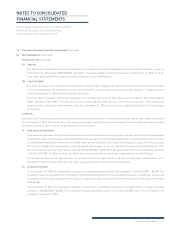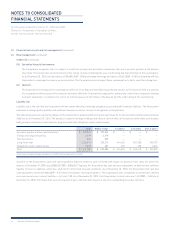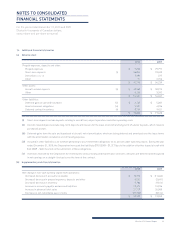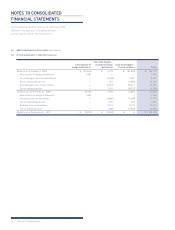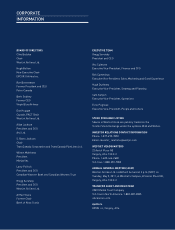Westjet 2010 Annual Report Download - page 90
Download and view the complete annual report
Please find page 90 of the 2010 Westjet annual report below. You can navigate through the pages in the report by either clicking on the pages listed below, or by using the keyword search tool below to find specific information within the annual report.
88 WestJet 2010 Annual Report
NOTES TO CONSOLIDATED
FINANCIAL STATEMENTS
For the years ended December 31, 2010 and 2009
(Stated in thousands of Canadian dollars,
except share and per share amounts)
13. Financial instruments and risk management (continued)
(c) Risk management (continued)
Fuel risk (continued)
Under the Corporation’s fuel price risk management policy, the Corporation is permitted to hedge a portion of its future anticipated jet fuel
purchases for up to 36 months, as approved by the Board of Directors. The policy establishes hedging limits based on time horizon. The hedging
program is designed to mitigate the risk of sudden and substantial movements in fuel prices causing volatility in earnings and cash fl ows.
Management continuously reviews and adjusts its strategy based on market conditions and competitors’ positions. Financial derivatives in
crude-oil-based commodities (including a variety of crude oil, heating oil and jet benchmarks) that are traded directly on organized exchanges
or are available over the counter can be useful in mitigating the risk of volatile fuel prices.
As at December 31, 2010, the Corporation had a mixture of Canadian-dollar West Texas Intermediate (WTI) and jet fuel call options and collars to
hedge approximately 20% (2009 – 14%) of its anticipated jet fuel requirements for the next 12 months. The following table outlines, per type, as
at December 31, 2010, the notional volumes per barrel (bbl.) or per gallon (gal.) along with the weighted average contract prices.
Type Year Instrument Notional volumes (bbl.) WTI average call price (CAD/bbl.)
WTI 2011 Call options 1,230,000 $ 97
Type Year Instrument Notional volumes (gal.)
Jet average call
price (CAD/gal.)
Jet average put
price (CAD/gal.)
Jet 2011 Collars 1,260,000 $ 2.50 $ 2.00
Upon proper qualifi cation, the Corporation accounts for its fuel derivatives as cash fl ow hedges. Under cash fl ow hedge accounting, the effective
portion of the change in the fair value of the hedging instrument is recognized in AOCL, while the ineffective portion is recognized in non-operating
income (expense). Upon maturity of the derivative instrument, the effective gains and losses previously recognized in AOCL are recorded in net
earnings as a component of aircraft fuel expense.
The Corporation’s policy for its fuel derivatives is to measure effectiveness based on the change in the intrinsic value of the fuel derivatives
versus the change in the intrinsic value of the anticipated jet fuel purchase. The Corporation elects to exclude time value from the measurement
of effectiveness; accordingly, changes in time value are recognized in non-operating income (expense) during the period the change occurs. As a
result, a signifi cant portion of the change in fair value of the Corporation’s options may be recorded as ineffective.
Ineffectiveness is inherent in hedging jet fuel with derivative instruments in other commodities, such as crude oil, particularly given the signifi cant
volatility observed in the market on crude oil and related products. Due to this volatility, the Corporation is unable to predict the amount of
ineffectiveness for each period. This may result in increased volatility in the Corporation’s results.
If the hedging relationship ceases to qualify for cash fl ow hedge accounting, any change in fair value of the instrument from the point it ceases
to qualify is recorded in non-operating income (expense). Amounts previously recorded in AOCL will remain in AOCL until the anticipated jet fuel
purchase occurs, at which time, the amount is recorded in net earnings under aircraft fuel expense. If the transaction is no longer expected to
occur, amounts previously recorded in AOCL will be reclassifi ed to non-operating income (expense). For the years ended December 31, 2010 and
2009, there were no amounts reclassifi ed as a result of transactions no longer expected to occur.
The periodic changes in fair value and realized settlements on fuel derivatives that do not qualify or that are not designated under cash fl ow hedge
accounting are recorded in non-operating income (expense). For the years ended December 31, 2010 and 2009, there were no fuel derivatives
not designated under cash fl ow hedge accounting.


